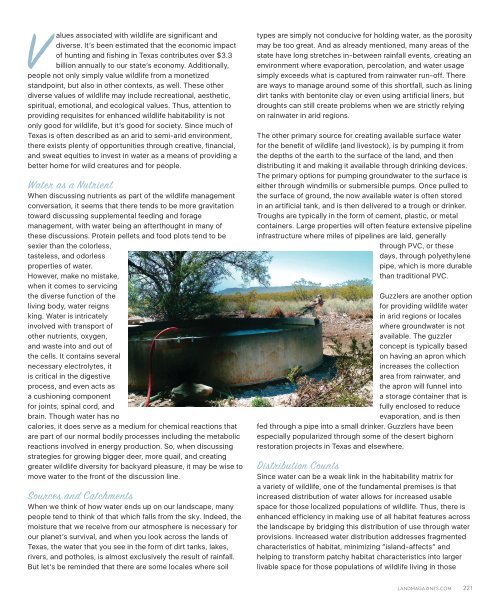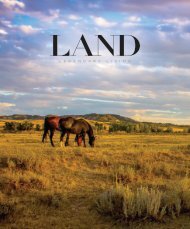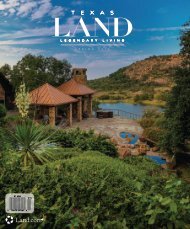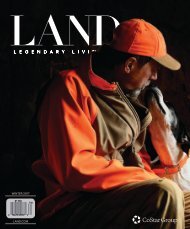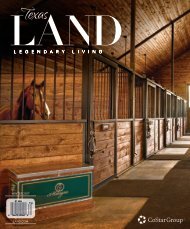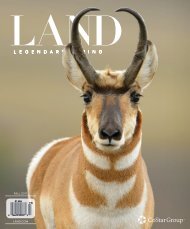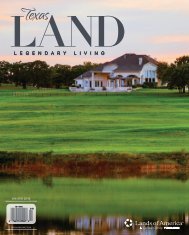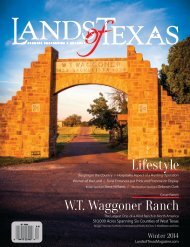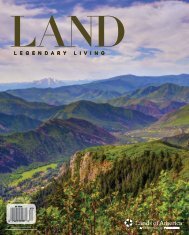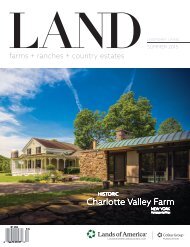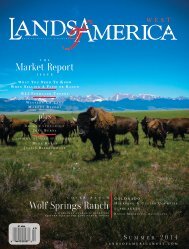Spring 2017
Texas LAND
Texas LAND
You also want an ePaper? Increase the reach of your titles
YUMPU automatically turns print PDFs into web optimized ePapers that Google loves.
V<br />
alues associated with wildlife are significant and<br />
diverse. It’s been estimated that the economic impact<br />
of hunting and fishing in Texas contributes over $3.3<br />
billion annually to our state’s economy. Additionally,<br />
people not only simply value wildlife from a monetized<br />
standpoint, but also in other contexts, as well. These other<br />
diverse values of wildlife may include recreational, aesthetic,<br />
spiritual, emotional, and ecological values. Thus, attention to<br />
providing requisites for enhanced wildlife habitability is not<br />
only good for wildlife, but it’s good for society. Since much of<br />
Texas is often described as an arid to semi-arid environment,<br />
there exists plenty of opportunities through creative, financial,<br />
and sweat equities to invest in water as a means of providing a<br />
better home for wild creatures and for people.<br />
Water as a Nutrient<br />
When discussing nutrients as part of the wildlife management<br />
conversation, it seems that there tends to be more gravitation<br />
toward discussing supplemental feeding and forage<br />
management, with water being an afterthought in many of<br />
these discussions. Protein pellets and food plots tend to be<br />
sexier than the colorless,<br />
tasteless, and odorless<br />
properties of water.<br />
However, make no mistake,<br />
when it comes to servicing<br />
the diverse function of the<br />
living body, water reigns<br />
king. Water is intricately<br />
involved with transport of<br />
other nutrients, oxygen,<br />
and waste into and out of<br />
the cells. It contains several<br />
necessary electrolytes, it<br />
is critical in the digestive<br />
process, and even acts as<br />
a cushioning component<br />
for joints, spinal cord, and<br />
brain. Though water has no<br />
calories, it does serve as a medium for chemical reactions that<br />
are part of our normal bodily processes including the metabolic<br />
reactions involved in energy production. So, when discussing<br />
strategies for growing bigger deer, more quail, and creating<br />
greater wildlife diversity for backyard pleasure, it may be wise to<br />
move water to the front of the discussion line.<br />
Sources and Catchments<br />
When we think of how water ends up on our landscape, many<br />
people tend to think of that which falls from the sky. Indeed, the<br />
moisture that we receive from our atmosphere is necessary for<br />
our planet’s survival, and when you look across the lands of<br />
Texas, the water that you see in the form of dirt tanks, lakes,<br />
rivers, and potholes, is almost exclusively the result of rainfall.<br />
But let’s be reminded that there are some locales where soil<br />
types are simply not conducive for holding water, as the porosity<br />
may be too great. And as already mentioned, many areas of the<br />
state have long stretches in-between rainfall events, creating an<br />
environment where evaporation, percolation, and water usage<br />
simply exceeds what is captured from rainwater run-off. There<br />
are ways to manage around some of this shortfall, such as lining<br />
dirt tanks with bentonite clay or even using artificial liners, but<br />
droughts can still create problems when we are strictly relying<br />
on rainwater in arid regions.<br />
The other primary source for creating available surface water<br />
for the benefit of wildlife (and livestock), is by pumping it from<br />
the depths of the earth to the surface of the land, and then<br />
distributing it and making it available through drinking devices.<br />
The primary options for pumping groundwater to the surface is<br />
either through windmills or submersible pumps. Once pulled to<br />
the surface of ground, the now available water is often stored<br />
in an artificial tank, and is then delivered to a trough or drinker.<br />
Troughs are typically in the form of cement, plastic, or metal<br />
containers. Large properties will often feature extensive pipeline<br />
infrastructure where miles of pipelines are laid, generally<br />
through PVC, or these<br />
days, through polyethylene<br />
pipe, which is more durable<br />
than traditional PVC.<br />
Guzzlers are another option<br />
for providing wildlife water<br />
in arid regions or locales<br />
where groundwater is not<br />
available. The guzzler<br />
concept is typically based<br />
on having an apron which<br />
increases the collection<br />
area from rainwater, and<br />
the apron will funnel into<br />
a storage container that is<br />
fully enclosed to reduce<br />
evaporation, and is then<br />
fed through a pipe into a small drinker. Guzzlers have been<br />
especially popularized through some of the desert bighorn<br />
restoration projects in Texas and elsewhere.<br />
Distribution Counts<br />
Since water can be a weak link in the habitability matrix for<br />
a variety of wildlife, one of the fundamental premises is that<br />
increased distribution of water allows for increased usable<br />
space for those localized populations of wildlife. Thus, there is<br />
enhanced efficiency in making use of all habitat features across<br />
the landscape by bridging this distribution of use through water<br />
provisions. Increased water distribution addresses fragmented<br />
characteristics of habitat, minimizing “island-affects” and<br />
helping to transform patchy habitat characteristics into larger<br />
livable space for those populations of wildlife living in those<br />
LANDMAGAZINES.COM<br />
221


